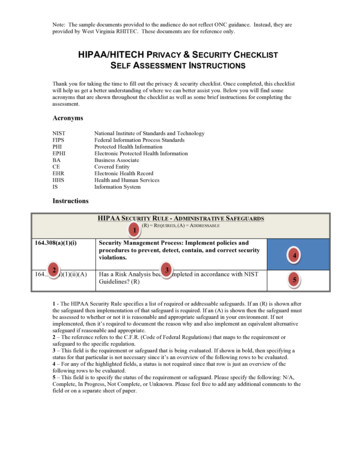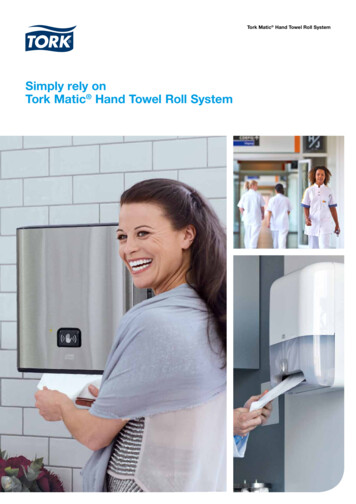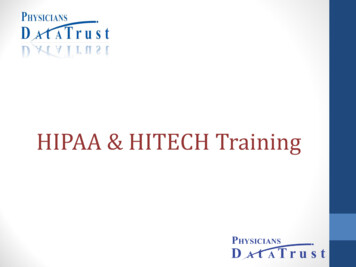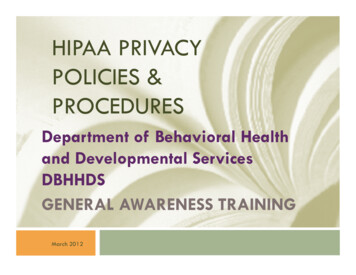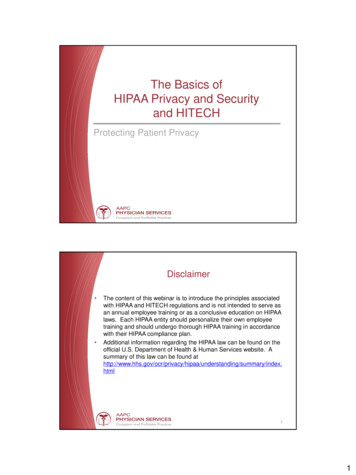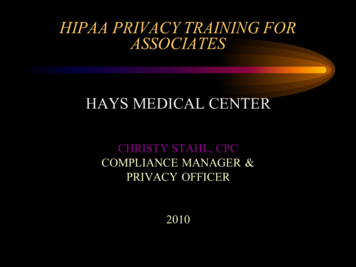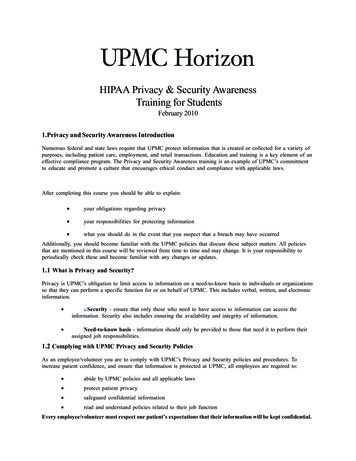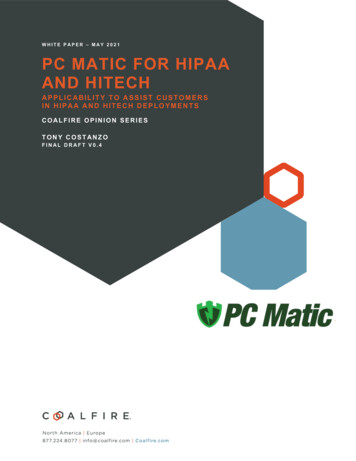
Transcription
WHITE PAPER – MAY 2021PC MATIC FOR HIPAAAND HITECHAPPLICABILITY TO ASSIST CUSTOMERSIN HIPAA AND HITECH DEPLOYMENTSCOALFIRE OPINION SERIESTONY COSTANZOFINAL DRAFT V0.4
TABLE OF CONTENTSExecutive Summary . 33Coalfire Opinion . 33Introducing the HIPAA Security Rule . 44The Relationship Between the Security Rule and the Privacy Rule . 55The Relationship Between HIPAA and HITECH . 55Suggestions for the Use of this PAG . 55Additional Useful Publications . 66Objectives of this White Paper . 66PC Matic Platform . 66PC Matic Core Services . 77Devices . 77Dashboard. 88Process Activity . 99Lifelines . 1010Vulnerabilities . 1111Threat Management . 1111Scope and Approach for Review . 1212Scope of Technology and Security Standard to Review . 1212PC Matic Suggested Use Case. 1212Coalfire Evaluation Methodology . 1313Evaluation of HIPAA Controls Scoring System . 1313Summary of Overall PC Matic Platform HIPAA Scoring . 1414Summary of Customer Responsibilities for HIPAA Standards . 1414PC Matic Platform Applicability to HIPAA . 1515PC Matic Applicability Detail . 1515Access Control . 1515Audit Controls. 1717Coalfire Conclusion . 1818A Comment Regarding Regulatory Compliance . 1818Legal Disclaimer . 1818Reference Materials . 1919PC Matic Applicability Guide for HIPAA/HITECH White Paper2
EXECUTIVE SUMMARYCOALFIRE OPINIONCoalfire Systems, Inc. (Coalfire) reviewed the PC Matic platform for its efficacy in providing its coveredentity and business associate (CE&BA) customers the ability to achieve or maintain compliance in theirsuccessful deployments using the PC Matic platform. The CE&BAs are identified as those entities that aredefined under the Health Information Portability and Accountability Act (HIPAA) and enforced by theprovision of the Health Information Technology for Economic and Clinical Health (HITECH) Act of 2009.The purpose of this opinion white paper is to identify how the PC Matic platform’s security capabilities,functions, and features align with the standards adopted by the Secretary of Health and Human Services(HHS) under the HIPAA of 1996 (HIPAA, Public Law 104-191) for protecting privacy and security of certainhealth information.The HIPAA Security Rule specifically focuses on the safeguarding of electronic protected health information(ePHI) through the implementation of administrative, physical, and technical safeguards. CE&BAorganizations are required to ensure the confidentiality, integrity, and availability of all ePHI that it creates,receives, maintains, or transmits, protect against any reasonably anticipated threats or hazards to thesecurity or integrity of such information, protect against reasonably anticipated unauthorized uses ordisclosures of protected health information (PHI), and ensure compliance by its workforce. In parallel tothe Security Rule, the HHS mandated Standards for Privacy of Individually Identifiable Health Information(Privacy Rule) establishes a set of national standards for protection of certain health information whilepromoting the necessary flow of health information to facilitate high quality health care.Practical implementation of a HIPAA compliance program typically requires the CE&BA have a solid RiskAnalysis and Risk Management framework with controls-based compliance guidelines, such as the NationalInstitute of Standards and Technology (NIST) Special Publication (SP) 800-53 or the InternationalOrganization for Standardization (ISO) ISO 27001. HIPAA Security Rule mandates define technicaloutcomes which the controls-based guidelines may be used to achieve. HIPAA itself does not deliver thelevel of technical and organizational controls required to have a comprehensive program of compliance.The PC Matic platform, as reviewed by Coalfire, can be effective in providing support for the outlinedobjectives and requirements of the HIPAA Security Rule in support of a HIPAA compliance program.Through proper implementation and integration into the organization’s greater technical infrastructure andinformation security management systems, PC Matic may be useable in a HIPAA-controlled environment.The organization wishing to use PC Matic should consider the guidance provided by the National Instituteof Standards and Technology, U.S. Department of Commerce (NIST) Special Publication (SP) 800-167Guide to Application Whitelisting, when designing their implementation.Coalfire Product Applicability Guides (PAGs) vary in their depth and focus based upon the product underevaluation. In this instance, the PC Matic platform was scored against a HIPAA controls matrix for fourtechnical safeguards. For simple products that target a single function, a PAG can make statements abouttheir use in a compliance program. For more complex products or platforms like the PC Matic platform thathave diverse capabilities and require significant configuration before use, Coalfire recommends narrowingdown the diversity by proposing a use case or scenario to measure its applicability to HIPAA (i.e., Privacyand Security Rules).This PAG may be useful for CE&BAs desiring to utilize application whitelisting technologies within theHIPAA Security Rule compliance program framework, as it discusses the relevant PC Matic platformsecurity capabilities applicable to supporting or addressing risks associated with application whitelisting andPC Matic Applicability Guide for HIPAA/HITECH White Paper3
the specifics of HIPAA Security Rule requirements. This white paper focuses on the technical securityfeatures (i.e., safeguards) and capabilities of the PC Matic platform as they align with these requirements.Use of the Terms Review and ControlCoalfire uses the term review as a notional method of conducting a use-case scenario in a hosted testenvironment on the Falcon Platform.In this PAG, Coalfire will use the term control to denote the application of an approach to a HIPAAsafeguard. Because it is customary that the CE&BA will use another controls framework (such as, NISTSP800-53 or ISO 27001) to create their actual program of security to satisfy the HIPAA Security Rule,Coalfire makes use of the term “control.”INTRODUCING THE HIPAA SECURITY RULEThe HIPAA Security Rule specifically focuses on the safeguarding of electronic Protected HealthInformation (ePHI) by implementing administrative, physical, and technical safeguards. Organizations thatmust comply with this rule face frequent challenges to safeguard ePHI from a myriad of internal and externalrisks. As it is a requirement of the Security Rule, compliance is mandatory for organizations defined byHIPAA as a CE&BA. The Security Rule is based on the fundamental concepts of flexibility, scalability, andtechnology neutrality. Therefore, no specific requirements for the types of technology to implement areidentified. The Security Rule allows a covered entity to use any security measures (as best determined bythe CE&BA) that allow it to reasonably and appropriately implement the standards and implementationspecifications (HHS, 2007). As a subset of information, under 45 CFR § 164.306 Security standards:General rules, these organizations are required to: Ensure the confidentiality, integrity, and availability of all ePHI the CE&BA creates, receives,maintains, or transmits. Protect against any anticipated threats or hazards to the security or integrity of such information. Protect against anticipated unauthorized uses or disclosures of PHI not permitted by the PrivacyRule. Ensure compliance with its workforce.Additionally, in § 164.306(b), the Flexibility of Approach provides key guidance for focusing compliancedecisions, including factors a covered entity must consider when selecting security measures such astechnology solutions. The requirements of the HIPAA Security Rule are organized according to safeguards,standards, and implementation specifications; the major sections include: Security Standards: General Rules Administrative Safeguards Physical Safeguards Technical Safeguards Organizational Requirements Policies and Procedures and Documentation RequirementsWhile the administrative, physical, and technical requirements identified under HIPAA are mandatory, theirimplementation may differ based on the type of requirement. Under the HIPAA Security Rule, standardsand implementation specifications are classified as either required or addressable. It is important to notePC Matic Applicability Guide for HIPAA/HITECH White Paper4
that neither of these classifications should be interpreted as optional. An explanation of each is providedbelow: Required – Implementation specifications identified as required must be fully implemented by thecovered organization. Furthermore, all HIPAA Security Rule requirements identified as standardsare classified as required. Addressable – The concept of an addressable implementation specification was developed toprovide covered organizations flexibility concerning how the requirement could be satisfied. Tomeet the requirements of an addressable specification, a covered organization must: (a) implementthe addressable implementation specification as defined; (b) implement one or more alternativesecurity measures to accomplish the same purpose; or (c) not implement an addressableimplementation specification or an alternative. If the organization chooses an alternative control ordetermines that a reasonable and appropriate alternative is not available, it must fully document itsdecision and reasoning.The Relationship Between the Security Rule and the Privacy RuleHIPAA required the Secretary of HHS to develop regulations protecting certain health information's privacyand security. To fulfill this requirement, HHS published what are commonly known as the HIPAA PrivacyRule and the HIPAA Security Rule. Within HHS, the Office for Civil Rights (OCR) enforces these rules withvoluntary compliance activities and civil money penalties (HHS, 2021). The Privacy Rule, or Standards forPrivacy of Individually Identifiable Health Information, establishes national standards to protect certainhealth information. The Security Standards for the Protection of Electronic Protected Health Information(known as the “Security Rule”) establishes a national set of security standards to protect certain healthinformation held or transferred in electronic form. The Security Rule operationalizes the protectionscontained in the Privacy Rule by addressing the technical and non-technical safeguards that coveredentities must put in place to secure individuals’ ePHI. This white paper's scope is to discuss how the PCMatic platform applies to the 4 HIPAA technical controls.The Relationship Between HIPAA and HITECHThe HITECH Act was enacted as part of the American Recovery and Reinvestment Act of 2009 to helppromote the adoption and use of health information technology. The HITECH Act was drafted andintegrated into the HIPAA framework to extend protections and address the privacy and security concernsassociated with the ePHI. HITECH introduces several new security standards and upgrades the existingstandards in HIPAA to protect healthcare stakeholders.The relationship between HITECH and HIPAA is in how HITECH strengthened the enforcement of theexisting HIPAA security standards. This consists of three notable impacts to enforcement of the existingHIPAA security standards which includes: The scope of compliance was expanded to include the Breach Notification Rule to HIPPA The sharing of responsibilities was extended from not only CE’s but now also includes BE’s The penalties for noncompliance were increased and a new tiered fee system was introducedSUGGESTIONS FOR THE USE OF THIS PAGThis white paper and the supporting controls workbook are intended to be used by various CE&BA andother interested parties involved in the sales, construction, operation, or infrastructure assessment basedon the PC Matic platform. It guides PC Matic customers in understanding the controls built into the coreinfrastructure space, as well as the general availability of control options that the customer may implement.PC Matic Applicability Guide for HIPAA/HITECH White Paper5
PC Matic’s customers may include hospitals and provider organizations; healthcare solution serviceproviders; Software as a Service (SaaS) providers, designated entities, others who share responsibility witha covered entity.ADDITIONAL USEFUL PUBLICATIONSThe National Institute of Standards and Technology (NIST) has also published Special Publication (SP)800-167, Application Whitelisting Guide. The purpose of this document is to explain the security concernsassociated with security technologies and make practical recommendations for addressing those concernswhen planning for, implementing, and maintaining application whitelisting platforms. While NIST SP 800167 is not specific to HIPAA, it can be useful guidance as it pertains to addressing the risk associated withapplication whitelisting.Other publications that are useful in understanding the NIST and HIPAA Security Rule are the following: NIST SP 800-66 Rev. 1., An Introductory Resource Guide for Implementing the Health InsurancePortability and Accountability Act (HIPAA) Security Rule.–This publication maps NIST SP 800-53 Rev. 4, Security and Privacy Controls for FederalInformation Systems and Organizations requirements to HIPAA Security Rule safeguards andrequirements and ties the HIPAA Security Rule to a framework for managing risk.OBJECTIVES OF THIS WHITE PAPERThe primary objective for this white paper is to render an opinion on the PC Matic platform’s suitability toassist customers in meeting the requirements of HIPAA using a particular reference architecture, which ispresented in detail here. It is the intent of the authors to use the following process to illustrate the findingsand satisfy these objectives: Choose a likely and relevant use case for the PC Matic platform Show the specific configuration used for a test scenario Reveal additional technical details of the applications used to host and secure the infrastructure Collect artifacts, perform sampling, and document findings on a per-control basis Make relevant statements about each control family and the particulars of the PC Matic platformimplementation that may support meeting objectives of controls Confirm Coalfire’s opinionAlthough the opinion itself may be helpful, this paper also contains a representative overview of manyaspects of the HIPAA process and practices. It is a secondary objective of this white paper to inform anewcomer to HIPAA of a technical approach to using application whitelisting to protect endpoint systems.Since the review of the PC Matic platform was not being conducted on an actual CE&BA, Coalfire focusedon the technical controls for HIPAA. Coalfire did not review organizational processes, training, procedures,written supporting materials, or other non-technical controls listed in the HIPAA Security Rule. Theresponsibility of HIPAA processes, such as organizational, procedural, and training controls, which pertainto the actuality of implementation by a CE&BA, falls on the customer.This paper contains a representative overview of many aspects of HIPAA Security Rule processes andpractices in the following section.PC MATIC PLATFORMPC Matic Applicability Guide for HIPAA/HITECH White Paper6
The PC Matic platform is a comprehensive enterprise-grade cyber security endpoint solution that utilizesglobally automated whitelisting technology, fileless malware detection, and remote desktop protocol (RDP)port protection from brute force attacks. The PC Matic platform helps healthcare organizations looking toprotect their environments and meet HIPAA requirements by augmenting the existing endpoint securitystack. The PC Matic platform achieves this by securing endpoints against threats through automating thewhitelisting and blacklisting process with the use of its globally supported and managed whitelisttechnology. Below in figure 1 is PC Matic’s whitelist management process compared to traditional whitelistmanagement methods.Figure 1: PC Matic Whitelist ManagementThe PC Matic platform provides proactive detection through the use of application whitelisting. Traditionalwhitelisting solutions require organizations to manually create whitelists for known good applications in theenvironment, which can create difficulties for security analysts to manage and keep up to date with thechanging application and development needs of most healthcare and enterprise environments.The PC Matic platform helps mitigate this by utilizing a globally automated whitelist solution managed by ateam of professional malware researchers that analyze the applications detected in the organizations andcategorizes them by level of threat.PC MATIC CORE SERVICESThe PC Matic platform contains the following features that assist healthcare and enterprise organizationswith managing the security of their endpoint environments. The core services are accessible from the PCMatic platform console, which provides the user with a centralized source for an organization’s endpoints.The PC Matic platform provides flexibility to organizations of any size to manage their environment withpre-configured, out of the box security for less hands-on organizations, while also providing advancedcapabilities for more in-depth configurations and control for organizations that require it.DevicesThe Devices tab allows the viewing of the endpoints that have the PC Matic platform shield installed. Fromthe device tab shown in figure 2, the status and health of the endpoints can be viewed, and action can betaken to manage the endpoints.PC Matic Applicability Guide for HIPAA/HITECH White Paper7
Figure 2: Devices Tab ViewThe endpoints can be placed in groups to allow for granular policy control according to best practices forthe organization’s environment, as seen in Figure 3.Figure 3: Example of GroupsThese groups can be managed from the console. Placing endpoints into groups allows organizations tomanage the settings, policies, and patch management of the endpoint agents by grouping them based onthe level of control or restrictiveness required.DashboardThe dashboard shown below in figure 4 provides a high-level view into endpoint events and health. Theview can be changed to show all device groups or the individual groups, with the ability to adjust the daterange to view current or historical events. The dashboard can be beneficial to organizations that need tomonitor specific endpoint groups or for the overall organization.PC Matic Applicability Guide for HIPAA/HITECH White Paper8
Figure 4: PC Matic Platform DashboardProcess ActivityThe process activity dashboard seen below in figure 5 provided by the PC Matic platform allows a securityanalyst to see all processes that have been executed in the environment. Understanding what processesare running on an endpoint and how they are being consumed is a key component to threat hunting.Identifying which processes were successful and which ones were unsuccessful gives a view of what isoccurring at the endpoint and if there are abnormalities that could represent a vulnerability.Figure 5: Process Activity DashboardPC Matic Applicability Guide for HIPAA/HITECH White Paper9
The process activity dashboard will show the process details shown in figure 6 including the vendor’s name,product, file hash, and other information that is vital to understanding what threats could be present on theendpoint.Figure 6: Detailed Process ActivityThe process activity dashboard will also disclose why a process was allowed or why it may have beenblocked. This allows a security analyst to gain real-time visibility into endpoints, detect threats, and take theproper action. Understanding all processes that are normal on an endpoint can be a difficult task withoutthe proper tools, which could lead to threats being missed because the processes can change due toupdates and other changes to the endpoint. A security analyst may have to spend time to detect if a processis truly malicious or a false positive.LifelinesThe PC Matic platform offers healthcare organizations Lifeline service options that make managing thesolution more accessible to organizations, especially in situations where facilities may not have onsite ITsupport staff to maintain day to day operations and may not possess the depth of experience in cybersecurity to keep on top of emerging threats. These Lifelines include services such as RDP Lifelines andRansomware Lifelines.Ransomware LifelinesRansomware Lifelines provides an out of the box solution that is designed for organizations with the needfor enterprise-level protections but may not have available security analysts or support staff to manage theday-to-day operations and configuration of the endpoint security tools. Ransomware Lifelines provides apre-configured and automated whitelist solution that is managed by a team of professional malwareresearchers that can automatically analyze and categorize blocked or unknown applications.RDP LifelinesRDP Lifelines gives organizations additional tools to protect against the risk of malicious attacks that canbe executed through exploiting the RDP ports. Security teams can leverage the capabilities in RDP Lifelineto manage the availability of the RDP sessions by scheduling available times or by enabling or disablingthe access per device as needed (as seen in Figure 7). All remote session activity is captured in acomprehensive audit log that enables visibility for security teams.PC Matic Applicability Guide for HIPAA/HITECH White Paper10
Figure 7: RDP Lifeline ControlsVulnerabilitiesManaging application vulnerabilities in the healthcare endpoint environment is a key requirement toeffectively develop a vulnerability management approach. Once the software discovery requirement issatisfied, vulnerability tools can be used to detect vulnerabilities that are present, and the steps required toremediate. This allows an organization to gain an understanding of the threat landscape that may bepresent at any time. However, these solutions require extensive staff and can be time consuming to performcorrectly. The PC Matic platform provides extensive reporting and complete endpoint visibility, giving theorganization a comprehensive view of the health of the endpoint and the processes and software that arerunning on the endpoint. This can reduce the manual effort that is often required to conduct softwarediscovery and mapping.THREAT MANAGEMENTFor healthcare organizations, meeting the requirements for HIPAA requires selecting the best antivirussolution for the endpoint systems that protects both the operation of the business and the patient data thatmay be accessible from the endpoints. The PC Matic platform augments the healthcare organizationsexisting endpoint zero-trust security strategy by filling in potential gaps in the organization’s overall security.The PC Matic platform approaches application whitelisting by analyzing several attributes of the applicationor files to determine whether it is a known good or a known bad. These attributes are populated and checkedagainst PC Matic’s custom Global Allowlist. The PC Matic platform provides flexibility when it comes toselecting the best application whitelisting approach for an organization’s environment. There are three mainapproaches to implementing application whitelisting that are configurable within the PC Matic platform: File & Folder Path Attributes - While this is not the most secure approach for application whitelisting,it offers a more convenient way for organizations to implement this solution quickly in theenvironment by selecting the file name, file size, or an entire directory the files reside in to be setas known good. This is typically a recommended solution for developers or application testers tohave a designated directory from which they can execute applications that may normally beflagged. Using this approach, however, could create a potential exploitable safe area for maliciouscode to be executed from. Digital Signature Attributes - This method offers more security by using the digital signatures ofapplications to verify the authenticity of the application publisher and detect if it has been modified,which could lead to potential malicious behavior. Cryptographic Hash Attributes - Using the cryptographic hash values of an application to identifythe unique hash identifier MD5, SHA-1, or SHA-256 value of the file is the most secure methodimplementing application whitelisting. This method, when combined with digital signatures,provides a secure and manageable solution to using application whitelisting in any environment.PC Matic Applicability Guide for HIPAA/HITECH White Paper11
One of the most common challenges for organizations implementing application whitelisting is managingfalse positives. False positives in traditional application whitelisting solutions occur when an application isblocked even though it was believed to be a known good application. This requires IT support staff tomanage a list of allowed applications and maintain it as new or updated applications are introduced into theenvironment.The PC Matic platform helps organizations manage application whitelists by providing a centralized platformand addressing the three main approaches of a mature whitelisting program, as described above.SCOPE AND APPROACH FOR REVIEWThe understanding of the PC Matic platform and its combined capabilities was gained through a productspecification and documentation provided by PC Matic and generally made available from PC Matic’spublic-facing website. Coalfire has further conducted interviews and engaged in live productdemonstrations with PC Matic personnel and subject matter experts. The Coalfire Opinion Series PAGsbenefit from the careful selection of possible and impactful use cases, highlighting critical areas within aproduct to evaluate potential HIPAA compliance.Coalfire’s review of the PC Matic platform began with a general alignment of the technology's applicabilityagainst the high-level HIPAA requirements and objectives. This was further narrowed down to specificrequirements that the PC Matic platform’s capabilities and features could support. An analysis of thereviewed technology capability to address applicable requirements was then conducted. This analysisprimarily focused on what an assessor might review when following HIPAA testing guidance during a HIPAAtechnical safeguards assessment.The review of requirements was comprehensive and included identifying gaps for which the technologymay not be sufficient to address. This does not include addressable requirements through other means,including, but not limited to, organizational procedures or the provision of additional third-party technologies.SCOPE OF TECHNOLOGY AND SECURITY STANDARD TO REVIEWThe review's primary focus included the features and functionality of the PC Matic platform, along with thesupporting underlying features and functionality as deployed in CE&BA architecture.For this review, Coalfire included requirements from the HIPAA of 1
The purpose of this opinion white paper is to identify how the PC Matic platform's security capabilities, functions, and features align with the standards adopted by the Secretary of Health and Human Services (HHS) under the HIPAA of 1996 (HIPAA, Public Law 104-191) for protecting privacy and security of certain health information.
